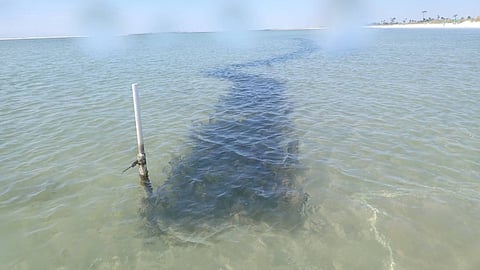

The Center for Coastal Solutions (CCS) of the University of Florida has begun a project wherein bamboo stakes are used to keep grazing marine species away from seagrass, thus ensuring room for the latter to recover.
Building on a 2024 pilot project led by former CCS postdoctoral research associate Beatriz Marin-Diaz, a 400-metre-long bamboo stockade was installed just outside of Panama City in May 2025. The approach has since been scaled up with thousands of stakes designed to withstand strong currents.
The need for seagrass intervention was identified after Hurricane Michael breached a barrier island in 2018, accelerating erosion at Buck’s Beach just off Tyndall Air Force Base.
Grazing by sea turtles and manatees further depleted the seagrass, leaving large barren patches that the bamboo exclosures are now helping to restore.
When the CCS field team set out in May, their goal was to install neat, side-by-side plots with and without bamboo to test the method over time. However, the shoreline had shifted so dramatically that much of the seagrass bed was already fragmented. The team adapted on the spot, building plots of varying sizes, pairing each with a control, and protecting as much seagrass as possible.
When the researchers returned to the area in September, just four months after the bamboo barriers were installed, they found that the only seagrass left standing in some areas was inside the bamboo plots.
“It’s a good example of why it’s important to understand cause and effect relationships in ecological systems,” said Patrick Saldaña, a postdoctoral research associate at the CCS who currently leads the project’s field work.
“Marin-Diaz recognised that grazers were weakening seagrass beds in an already altered environment. And through identifying that, she was able to develop a solution to at least temporarily mitigate that problem. And it’s been highly effective.”
This effort is part of a broader submerged shoreline project in collaboration with the Nature Conservancy, the Naval Research Laboratory, and Jacobs. By combining living shoreline techniques with submerged artificial reef structures, the project aims to reduce wave erosion and offer a more durable solution to seagrass loss.
Building on this work, the team has been preparing a research paper to share results from the pilot project while continuing to track how quickly the seagrass meadow is changing.
The Naval Research Laboratory is using sonar to map shifts in bed elevation and create detailed underwater terrain maps, while CCS researchers are measuring grazed and ungrazed plots.
CCS said that, in a rapidly changing meadow like Buck’s Beach, aerial imagery and satellite data are unable to keep up, making the on-the-ground and underwater monitoring techniques essential.
Monitoring and maintenance of the bamboo exclosures will continue in the months ahead. Because bamboo is biodegradable, the structures require periodic upkeep to remain effective.
